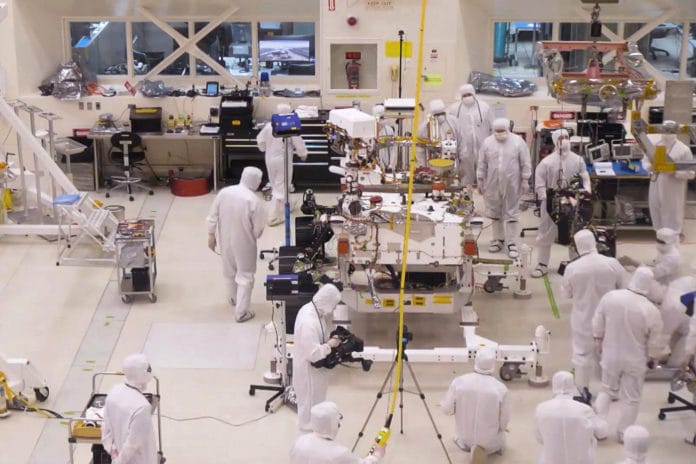We are just a year away from the launch of the Mars 2020 Mission – scheduled on July 17, 2020 – which will see NASA’s new Rover reaching the Red Planet on February 18, 2021. Once the rover reaches in Jezero Crater, it will start searching for signs of past life, cache rock samples and prepare the way for human exploration.
The mission is not long from now, and accordingly, the rover has really started to take shape. Constructing an exquisitely complex vehicle like the Mars 2020 rover takes serious teamwork.
The major milestone came out when the engineers at NASA’s Jet Propulsion Laboratory in Pasadena, California, installed six wheels and legs, known as mobility suspension to the Mars 2020 Rover. The imagery for this was taken on June 13, 2019, from a camera above the Spacecraft Assembly Facility. You can watch the video given below, which has been sped up by 300% and focuses only on major activities that took place the day to install the wheels.
The more complex task for the team’s integration efforts was to install “rocker-bogie” suspension system, which keeps the rover body balanced and enable it to “rock” up or down, depending on the various positions of the six wheels. The rover’s aluminum wheels measure 52.5 centimeters (20.7 inches) in diameter, each having its own motor and machined with 48 traction-providing cleats or grousers.
Read more: SpaceBok, a jumping robot built to explore the moon, Mars and asteroids
Besides, the two front wheels and two rear wheels have their own steering motors, which will allow the vehicle to turn a full 360 degrees while standing in place.
The wheels, you see in the video, are engineering models that will be replaced with flight models next year. After a few days of wheel installation, engineers installed the rover’s robotic arms, its mast-mounted camera, and the Sample Caching System (SCS).
“Charged with returning astronauts to the Moon by 2024, NASA’s Artemis lunar exploration plans will establish a sustained human presence on and around the Moon by 2028. We will use what we learn on the Moon to prepare to send astronauts to Mars,” said the team.
